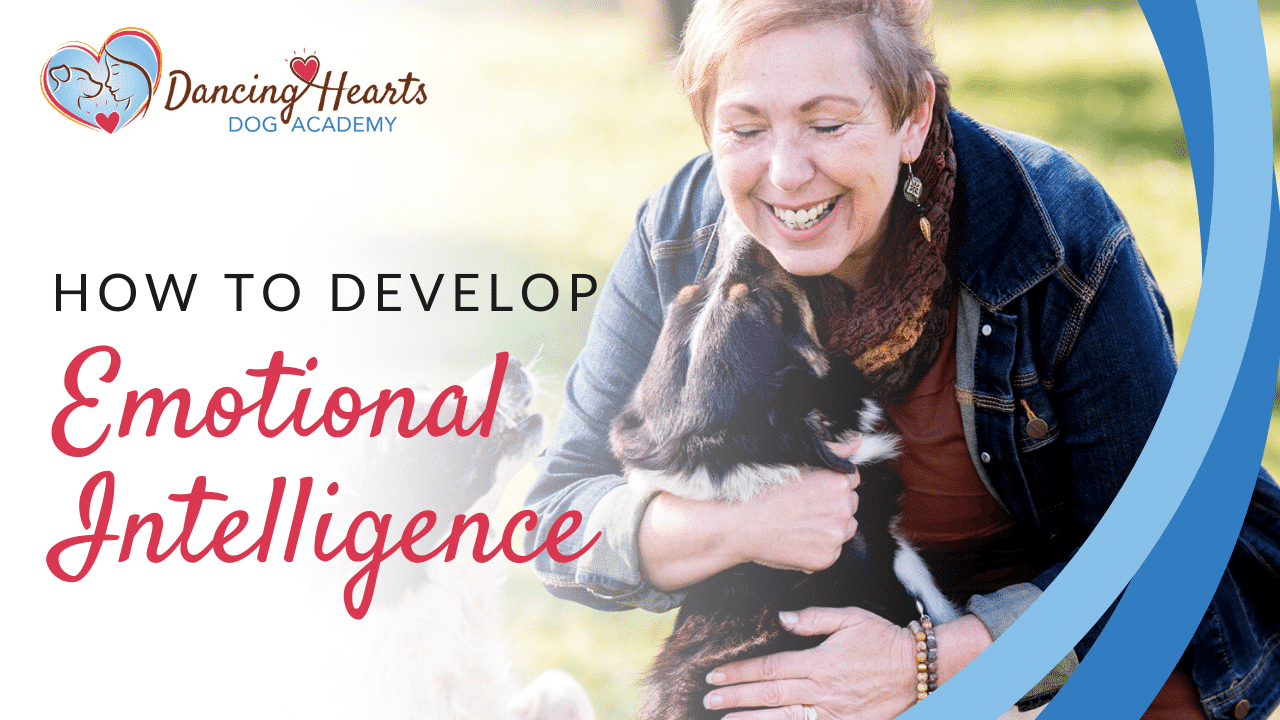Dogs are socially intelligent animals. Some might say that they can be even more socially intelligent than some humans, but I’ll leave that one up for debate!
In this post, I want to open your mind surrounding emotional intelligence and show you how to develop your own emotional intelligence and your dog’s too!
How do socially intelligent animals use emotion?
Animals can’t talk in the traditional sense. They communicate in other ways and often rely on nonverbal cues to demonstrate their feelings about any given situation.
Linda Kohanov is known for her ground-breaking work on social intelligence and her book, ‘The Power of the Herd,’ where she explores how horses use social and emotional intelligence to communicate and thrive.
Here’s a quote from Linda that I want to share with you…
“Socially intelligent animals use emotion as information to engage surprisingly agile responses to environmental stimuli and relationship challenges.”
Yes, Linda is talking about horses here. But we can learn a lot from her findings and incorporate some of her key principles to help develop emotional intelligence in our own herds.
In his book, ‘Beyond Words: What Animals Think and Feel,’ researcher, Carl Safina, explores the emotional intelligence of leaders in animal matriarchs such as wolf packs and elephant herds. He discovered that the family groups were significantly impacted by the emotional intelligence of the matriarch (aka the leader).
In our packs with our dogs, we are the leaders. So, if our dogs are significantly impacted by our emotional intelligence, it’s probably something that we should work on, right?
Although she worked mainly with horses, we can learn a lot from both Linda Kohanov and Carl Safina’s research and apply many of their key lessons to our lives with our dogs.
What is emotional intelligence?
Emotional intelligence is the ability to understand and manage your emotions. This theory of emotional intelligence was brought about by a man called Daniel Goleman. Daniel wrote a book, “Emotional Intelligence: Why It Can Matter More Than IQ” in 1995.
Daniel discussed the 5 key skills of emotional intelligence:
- Self-Awareness
- Self-Regulation
- Motivation
- Empathy
- Social Skills
One of the main takeaways from Daniel’s findings is that it’s up to us, as dog moms and the leaders of our packs, to understand the role that emotions play. People who excel in their careers, relationships, and so on, tend to be fluent in each of the 5 key skills of emotional intelligence.
If you think about your relationship with your dog from this perspective, it makes sense to conclude that the more we can develop our own emotional intelligence, the better our life with our dogs will become.
Now we know what the 5 skills of emotional intelligence are, let’s dig a little deeper into each one.
-
Self-Awareness
First, we have self-awareness. To be self-aware means that you understand your emotions as they occur ‘in the moment.’ You see emotions as being either appropriate or inappropriate in the situation you currently face. Being self-aware makes you a better dog mom because you know what ‘inappropriate’ emotions (or reactions) might have a negative effect on your dog. You must actively try to become self-aware.
But how can you become more self-aware?
One activity that has helped me improve my self-awareness is journaling. Putting pen to paper and exploring your thoughts and feelings through the process of writing is a great way to get to know yourself better. You can also try just slowing down and thinking about your emotions.
-
Self-Regulation
Leaning how to regulate your emotions is key if you want to become a great leader for your dog. Sometimes it can be tempting to make quick decisions about something but responding in this way can have consequences.
Regulating your emotions is about self-control. When your dog does something that makes you angry at first, your impulse may be to react out of anger. But, the skill of self-regulation will help you to make a better decision and help you learn how to manage your emotional responses appropriately.
-
Motivation
Sometimes, finding motivation can be difficult, especially when we’ve had a hard day and we just want to give in to our emotions (whether they’re good or bad!).
Motivation is an important skill of emotional intelligence. It is the personal drive we need to commit and achieve our goals. It fuels optimism, resilience, and helps us to act when opportunities for learning or growth arise.
To help you get motivated, ask yourself why you have a dog? Why did you invite your dog into your life? Your answer to these questions should be enough to motivate you to keep going and keep trying to be the best dog mom you can be for your dog.
-
Empathy
Empathy is an awareness of how others feel. Being able to see things from someone else’s perspective is so important because it helps you to understand others and develop deep and meaningful relationships.
You must show empathy to your dog. Stepping into your dog’s paws and trying to understand how they feel is crucial. You cannot have a good partnership with your dog without empathy.
If you want to earn respect and trust from your dog, you must become empathetic and practice empathy regularly.
-
Social Skills
The skill of understanding how you communicate and how it’s received by others is vitally important. Social skills go beyond the human-to-human connection. You also need adequate social skills to be able to bond and interact with your dog!
Marc A. Brackett, a research psychologist and the Founding Director of the Yale Center for Emotional Intelligence, found that when we avoid feelings by pushing them away, it can yield detrimental results.
If your dog is expressing their emotions to you and you ignore or distract them from their emotions (by giving them treats for example), you are inadvertently teaching your dog that their emotions do not matter. It’s very sad and you might not even be aware that you’re doing it, but it’s something to keep in mind and watch out for.
4 Steps to Emotional Balance
We can learn a lot from the work of Linda Kohanov. Yes, she worked with horses but a lot of what she talks about in her books can be applied to our dogs and our relationships with our dogs.
One key takeaway is that horses and other social animals like wolves, elephants and dogs, do not suppress their feelings. However, they don’t outlandishly express them either. Instead, animals like horses employ a four-point method that “uses the body’s intelligent and efficient use of emotion as a non-verbal communication system.”
- Feel the emotion in its purest form
- Get the message behind the emotion
- Change something in response to the message that you’ve received
- Go back to grazing, let it go, and get on with life
Animals, such as our dogs, are models of emotional sanity. I mean, look at how well they manage their emotions compared to some of us humans? There is no hasty reactions or decisions. They conserve energy for true emotions, which I think is fascinating.
Emotions are messages!
We can learn so much from socially intelligent animals. Many people don’t realize that emotions are messengers. Take fear as an example. Fear is a message to the brain that your wellbeing or even your life is in danger. Before you react hastily, ask yourself what is the message behind this emotion I’m feeling? What is the threat? And, what action should I take next to move to a position of safety?
If you remain stagnant and you don’t take action, the fear you felt intensifies to anxiety, confusion, stress, panic, and so on. This also happens with our dogs.
So, whenever you notice that your dog is fearful, think about why that is. What is the trigger of the fear that they are feeling? And, what can you do as their dog mom to help stop that emotion of fear from intensifying?
I hope that all of this has helped you gain a deeper understanding of your emotions and how you can help improve your emotional intelligence so that you and your dog can finally understand one another.
If you’d like to work with me and learn how to create a partnership lifestyle for you and your dog, you can request an invitation to join us in the Brilliant Partners Academy when the doors open for the next enrolment!
You can listen to everything I talked about in this blog post over on my podcast – Enlightened By Dogs. It’s episode 110, which you can listen to here.
Watch a short trailer for the episode below:






One Response
Great article. But what do we do when our dogs don’t have emotional intelligence and they do react hastily and are not showing emotional sanity? We have a wee border collie rescue who clearly hasn’t been socialised at all and has suffered abuse. Her first reaction to most things is with her teeth. How can I enable her to become emotionally stable and know the world isn’t out to get her?